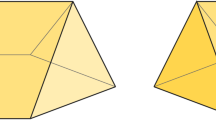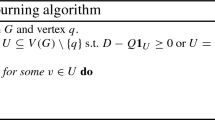Abstract
We present and prove recursive formulas giving the maximal number of leaves in tree-like polyominoes and polycubes of size n. We call these tree-like polyforms fully leafed. The proof relies on a combinatorial algorithm that enumerates rooted directed trees that we call abundant. We also show how to produce a family of fully leafed tree-like polyominoes and a family of fully leafed tree-like polycubes for each possible size, thus gaining insight into their geometric characteristics.
Access this chapter
Tax calculation will be finalised at checkout
Purchases are for personal use only
Similar content being viewed by others
References
Aval, J.-C., D’Adderio, M., Dukes, M., Hicks, A., Le Borgne, Y.: Statistics on parallelogram polyominoes and a \(q, t\)-analogue of the narayana numbers. J. Comb. Theory Ser. A 123(1), 271–286 (2014)
Barcucci, E., Frosini, A., Rinaldi, S.: On directed-convex polyominoes in a rectangle. Discrete Math. 298(1–3), 62–78 (2005)
Blondin Massé, A.: A sagemath program to compute fully leafed tree-like polycubes (2016). https://bitbucket.org/ablondin/fully-leafed-tree-polycubes
Bousquet-Mélou, M., Guttmann, A.J.: Enumeration of three dimensional convex polygons. Ann. Comb. 1(1), 27–53 (1997)
Bousquet-Mélou, M., Rechnitzer, A.: The site-perimeter of bargraphs. Adv. Appl. Math. 31(1), 86–112 (1997)
Castiglione, G., Frosini, A., Munarini, E., Restivo, A., Rinaldi, S.: Combinatorial aspects of L-convex polyominoes. Eur. J. Comb. 28(6), 1724–1741 (2007)
Champarnaud, J.-M., Dubernard, J.-P., Cohen-Solal, Q., Jeanne, H.: Enumeration of specific classes of polycubes. Electr. J. Comb. 20(4), 26 (2013)
Delest, M.-P., Viennot, G.: Algebraic languages and polyominoes enumeration. Theoret. Comput. Sci. 34, 169–206 (1984)
Garey, M.R., Johnson, D.S.: Computers and Intractability. Freeman, San Francisco (1979)
Goupil, A., Cloutier, H., Nouboud, F.: Enumeration of polyominoes inscribed in a rectangle. Discrete Appl. Math. 158(18), 2014–2023 (2010)
Goupil, A., Pellerin, M.E., de Wouters d’Oplinter, J.: Partially directed snake polyominos. arXiv:1307.8432v2 (2014)
Guttmann, A.J.: Polygons, Polyominoes and Polycubes. Springer, Heidelberg (2009). https://doi.org/10.1007/978-1-4020-9927-4
Hochstättler, W., Loebl, M., Moll, C.: Generating convex polyominoes at random. Discrete Math. 153(1–3), 165–176 (1996)
Jensen, I.: Enumerations of lattice animals and trees. J. Stat. Mech. 102(18), 865–881 (2001)
Klarner, D.A., Rivest, R.L.: A procedure for improving the upper bound for the number of n-ominoes. Can. J. Math. 25, 585–602 (1973)
Knuth, D.E.: Polynum, program available from knuth’s. http://Sunburn.Stanford.EDU/~knuth/programs.html#polyominoes (1981)
Redelmeyer, D.H.: Counting polyominoes: yet another attack. Discrete Math. 36(3), 191–203 (1981)
Author information
Authors and Affiliations
Corresponding author
Editor information
Editors and Affiliations
Rights and permissions
Copyright information
© 2018 Springer International Publishing AG, part of Springer Nature
About this paper
Cite this paper
Blondin Massé, A., de Carufel, J., Goupil, A., Samson, M. (2018). Fully Leafed Tree-Like Polyominoes and Polycubes. In: Brankovic, L., Ryan, J., Smyth, W. (eds) Combinatorial Algorithms. IWOCA 2017. Lecture Notes in Computer Science(), vol 10765. Springer, Cham. https://doi.org/10.1007/978-3-319-78825-8_17
Download citation
DOI: https://doi.org/10.1007/978-3-319-78825-8_17
Published:
Publisher Name: Springer, Cham
Print ISBN: 978-3-319-78824-1
Online ISBN: 978-3-319-78825-8
eBook Packages: Computer ScienceComputer Science (R0)




